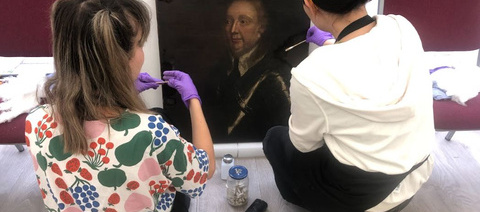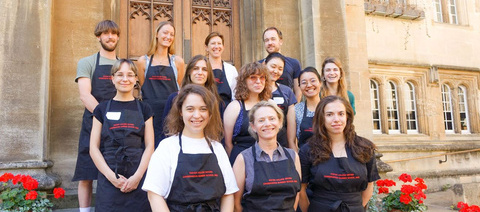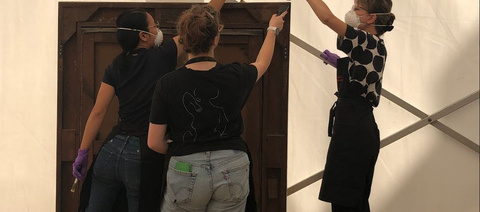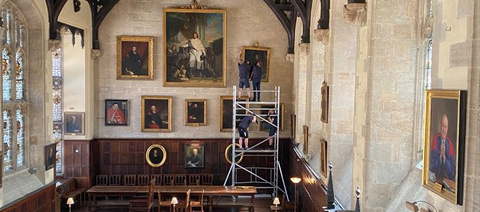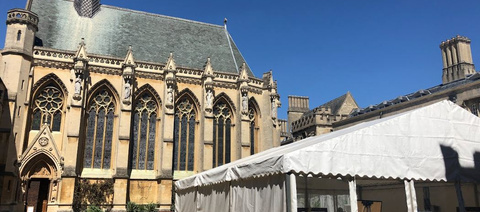Exeter College Summer Conservation School 2022
In August 2022, a group of twelve young painting conservators from three institutions gathered at the Exeter College Conservation Summer School, Oxford University, to treat and condition-check a number of college paintings.
What was the goal the project set out to achieve?
Georgina Dennis and Marie-Christine Livage organised the summer school with the aim of bringing together an international group of young conservators to work in situ, condition-check, and treat seven portrait paintings and frames from the college’s dining hall. The paintings date from the 17th to 20th century and all had varying needs. The college’s priorities had to be taken into consideration during this process.
What did I do?
During the two weeks, I got the opportunity to work on four different paintings, and two gilded frames. Most of the work was carried out in a tent set up in the college courtyard, coinciding with the August heatwave.
We divided into groups, with at least one member from each institution (University of Amsterdam, Hamilton Kerr Institute, and the Courtauld Institute of Art). A matching set of forms were used by each team to ensure consistent documentation of the work. All paintings were photographed, unframed, and surface cleaned. After several decades, they had accumulated layers of dirt and dust. They too had suffered some canvas distortions and impact cracking from trapped debris.
I was initially involved in the surface cleaning of a portrait of Edwin Lankester. However, I shortly rotated to help out on the dining hall balcony, where the large portrait of Narcissus Marsh required an additional pair of hands. The five of us worked together in the tight space, consolidating and surface cleaning.
In the second week, I worked on the portrait of Sir John Acland. The sitter was fading into the dark background. After surface cleaning, varnish removal was initiated on a tight schedule. The discovery of extensive retouching marking the outlines of the armour necessitated a change of approach, and we soon switched from solvent to gels, with final cleaning touches with evolon. A limited set of resources meant that the work was undertaken on the floor, with the painting securely propped-up against a whiteboard turned sideways – highlighting the realities of in-situ work.
What was the outcome?
Perhaps the most satisfying moment was witnessing the portraits being re-hung on the dining hall walls, in their much-improved state. Comparison of the before and after photos highlighted the differences the paintings and frames had undergone, having lost their dull grey quality after being rid of centuries of dust and yellowed varnishes. New forms had emerged; such as the chalk drawings of Edwin Lankester and the inscription in the portrait of John Conant. It was wonderful to see how much we had achieved in just two weeks.
What did I learn?
What was great about the summer school was that there was no discrimination in tasks based on skill – Georgie and Marie-Christine made sure everyone got to try their hand at everything, regardless of whether you were a first-year or third-year.
I had the opportunity to use a variety of materials that were new to me: for example a number of gels (xanthan, pemulen, and klucel G), evolon, eisenglass, pH-meter, the solvent star, and a range of dry-cleaning methods. The time constraints allowed me to gain experience with a range of materials that I would be unlikely to acquire in a slower studio environment in the same time frame.
In addition to getting such a wide overview of different materials, I could also observe others at work, ask questions, and see how they approached certain problems. It was fascinating to see the slightly different approaches and preferences between the students, and there were certainly some notable ones between the institutions. Many debates were held over our varying approaches, leading to interesting discussions and outcomes.
It was invaluable to be a part of such an international, diverse group of other young ambitious conservators, working closely over the period of two weeks. This experience helped to put into practice the skills learned in my first year and made me realise just how much I could already do.
For any enquiries, please get in touch at [email protected].
Working in a fast-paced environment where work had to be completed with limited resources and strict time constraints was not only beneficial in introducing me to a wide range of materials, but also in undertaking systematic testing, developing my communication to efficiently work in a team, as well as treatment decision-making.

